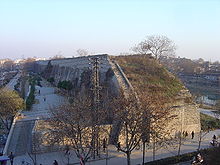- City Wall of Nanjing
-
The City Wall of Nanjing was designed by Emperor Zhu Yuanzhang (r. 1368-1398) after he founded the Ming Dynasty(1368-1644) and established Nanjing as the capital 600 years ago. To consolidate his sovereignty and keep out invaders, he adopted the suggestions of advisor Zhu Sheng to build a higher city wall, to collect grains and to postpone the coronation. Then, he started to build the city wall. It took 21 years for the project, which involved 200,000 laborers to move 7 million cubic meters of earth. The City Wall of Nanjing was among the largest city walls ever constructed in China,[1] and today it remains in good condition and has been well preserved.[2]
Contents
History
The first Ming emperor was proclaimed in 1368 and a great deal of preparation was done prior to this to have an imperial city and all the imperial trappings ready in time. The name of the city was changed again to Yingtianfu (responding to heaven). A "new city" was built to the east of the old one to be used as a new palace or "forbidden" city. This city was laid out in much the same pattern as Beijing; indeed Nanjing’s was the pattern for Beijing’s Forbidden City.
In expanding the walls, it appears the Hongwu Emperor intended initially to simply add a bulge to the existing walls and encompass the New City to the east. The main north gate would have been the Drum Tower. However, a decision was made to bring Lion Hill to the northwest into the city defenses for strategic reasons, and this almost doubled the area the walls would encompass. In addition to the surviving walls of stone and brick, an outwall was built along the river and to the south as an additional defensive measure. Old maps show that there were close to twenty walls in this rammed earth wall. This outwall is long gone, but the names of the gates survive as local place names. Part of the wall on the south shore of Xuanwu Lake was built on the foundations of the old Stone City walls from the Six Dynasties period, and reused many of the bricks from that old wall.
Originally, thirteen gates were built through Nanjing’s walls, but this number had grown to eighteen by the end of the Qing dynasty. Of the thirteen original gates, only Zhonghua Gate in the south, originally known as Jubao Gate, and Heping Gate in the north, originally called Shenci Gate, are still standing. Heping Gate is closed to the public as it is still used as an army barracks. Parts of other gates survive or have been partially reconstructed. The remains of a west gate, Hanzhongmen, originally called Shichengmen, stand in the middle of a plaza. These walls are part of the last of a series of three or four courtyards that made up the gate complex. During the Qing dynasty three more gates were added, including an entrance to Xuanwu Lake from the west built in 1910. Yijiang Gate on North Zhongshan Road was built in 1921, as was the major entrance to the city during Republican times when most visitors to the city arrived by boat at the docks just to the west.
Construction
Different from ancient city walls in Beijing and Xi'an, its design and construction was unique and changed the old ways of equilibrium and symmetry. The construction concentrated on military defense because the city was at the foot of a mountain-- a natural barrier to control the commanding elevation with the river as its natural city moat. Because of this, the 60-square-kilometer Nanjing city became strategically located and difficult to reach.
Nanjing's city wall belonged to a military defensive system too. The difference was that it adopted a winding, free style, based on the city's complicated topography. Construction of the Beijing and the Xi'an city walls was in the ancient style of square or rectangular design. When it was built by the second son of Emperor Zhu Yuanzhang, the dozen-kilometer long Xi'an city wall became the seat of local government. It could not match the scale of the capital Nanjing at that time.
Today
Today the 600-year-old city wall of Nanjing still stands. Experts from Nanjing Cultural Relic Bureau say most of the foundations use granite, rectangle stones or limestone. The walls were packed layer by layer with broken bricks, gravel and yellow earth. All the brickwork joints were poured with mixed lime, water in which glutinous rice had been cooked and tong oil because the coagulated mixture was very strong. That is why the city wall has stood for a long time. On top of the outer wall were 13,616 crenellations, or battlements, for defenders of the city to observe the enemy or dodge arrows. Opposite it was the parapet wall used as a balustrade to keep the defenders and horses safe. Standing on the wall, you will see tall ancient trees under your feet. Aside the top wall there are stone sluices to drain rain and near the wall's foundation there are further outlets. This, perhaps, is another reason for its powerful foundation and defense projects. The ancient city wall was listed as a key cultural relic under state protection in 1988.
Gallery
Notes
- ^ Ansight Guides (1997). Insight Guides: China 5/E. Apa Publications, original from Pennsylvania State University. p. 268. ISBN 0395662877.
- ^ Turnbull, Stephen R. and Steve Noon (2009). Chinese Walled Cities 221 BC-AD 1644. Osprey Publishing. p. 61. ISBN 1846033810.
See also
External links
Categories:- Chinese city walls
- Buildings and structures in Nanjing
Wikimedia Foundation. 2010.














